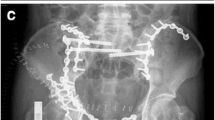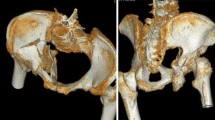Summary.
Between 1982 and 1995, 84 patients with displaced acetabular fractures underwent open reduction and internal fixation in our institution. The mean follow-up was 5.5 years with a minimum of 2 years. There were 33 simple and 51 complex fractures according to the classification of Judet and Letournels. Reduction after operation was anatomical in 49% of the patients, satisfactory in 24%, and unsatisfactory in 27%. Using Merle d’Aubigné’s scale, the clinical results were excellent in 39% of the patients, good in 29%, fair in 8%, and poor in 24%. Factors of statistical significance associated with a poor clinical outcome were T-shaped fractures, unsatisfactory reduction (>3 mm residual displacement), age >40 years and development of avascular necrosis. Acetabular surgery is demanding, and a high rate of complications can be expected. Trauma centres should designate a group of surgeons who will consistently treat these fractures in order to obtain more experience and better results.
Résumé. Entre 1982 et 1995, 84 patients présentant des fractures déplacées de l’acétabulum ont eu une réduction ouverte avec fixation interne. Le suivi a été en moyenne de 5,5 ans avec des extrêmes de 2 à 13 ans. Selon la classification de Judet et Letournel, 33 fractures étaient simples (39%) et 51 complexes (61%). Après l’opération, la réduction était considérée anatomique dans 49% des cas, satisfaisante dans 24% et mauvaise dans 27%. Avec l’échelle de Merle d’Aubigné, les résultats cliniques ont été excellents dans 39% des cas, bons dans 29%, médiocres dans 8% et mauvais dans 24%. Les facteurs statistiquement significatifs des mauvais résultats ont été: les fractures en ”T”, la réduction non satisfaisante (+ de 3 mm de déplacement résiduel) à l’âge de plus de 40 ans et la survenue d’une nécrose avasculaire. Le résultat de cette série confirme que la chirurgie acétabulaire est difficile et que le taux de complications peut être élevé. Il est recommandable de limiter à un groupe de chirurgiens le traitement opératoire de ces fractures afin d’obtenir une plus grande expérience et des meilleurs résultats.
Similar content being viewed by others
Author information
Authors and Affiliations
Additional information
Accepted: 2 July 1998
Rights and permissions
About this article
Cite this article
Fica, G., Cordova, M., Guzman, L. et al. Open reduction and internal fixation of acetabular fractures. International Orthopaedics SICOT 22, 348–351 (1998). https://doi.org/10.1007/s002640050275
Issue Date:
DOI: https://doi.org/10.1007/s002640050275




